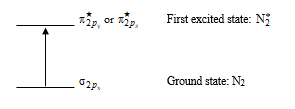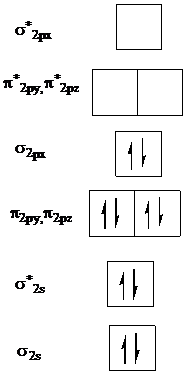
Concept explainers
Consider an
molecular orbital is promoted to the lowest empty molecular orbital. (a) Identify the molecular orbitals involved, and sketch a diagram to show the transition. (b) Compare the bond order and bond length of
Interpretation:
The molecular orbitals involved in the transition of an electron in a
Concept introduction:
Two atomic orbitals combine in order to form a bonding and an antibonding molecular orbital. The orbitals that lie on internuclear axis combine to form
The molecular orbital formed by the combination of
Molecular orbital formed by the combination of
Molecular orbitals formed by combining
Electrons are filled in the molecular orbitals in increasing order of energy.
Bond order is determined by subtracting the number of electrons in antibonding orbitals from the number of electrons in bonding orbitals and dividing by two.
Higher the bond order, smaller is the bond length.
Paramagnetic substances possess net spin and a diamagnetic substance has zero spin.
The energy of the photon emitted is given by the expression as follows:
Here,
Answer to Problem 114AP
Solution:
a) One electron of

b) Bond order of
c)
d)
Explanation of Solution
a) The molecular orbitals involved to be identified and a diagram to show the transition.
The electronic configuration of a nitrogen atom is as follows:
The molecular orbital diagram for

The highest occupied molecular orbital in
Thus, promote one electron of

Explanation:
b) Comparison of bond order and bond length of
In
The bond order of
In
The bond order of
Hence bond order of
Thus, the bond length of
Explanation:
c)
The excited state of
Explanation:
d) The energy difference between two levels, when
The energy difference between the excited state and the ground state is equal to the energy of the photon emitted.
The energy of the photon is given by the expression as follows:
Here,
Here, the wavelength
Substitute
Hence, the energy difference between the ground state and excited state is
Want to see more full solutions like this?
Chapter 9 Solutions
CHEMISTRY >CUSTOM<
- > Can the molecule on the right-hand side of this organic reaction be made in good yield from no more than two reactants, in one step, by moderately heating the reactants? esc ? A O O •If your answer is yes, then draw the reactant or reactants in the drawing area below. You can draw the reactants in any arrangement you like. • If your answer is no, check the box under the drawing area instead. olo 18 Ar Explanation Check BB Click and drag to start drawing a structure. 2025 McGraw Hill LLC. All Rights Reserved. Terms of Use | Privacy Center Accessibilityarrow_forwardName the structurearrow_forward> For each pair of substrates below, choose the one that will react faster in a substitution reaction, assuming that: 1. the rate of substitution doesn't depend on nucleophile concentration and 2. the products are a roughly 50/50 mixture of enantiomers. Substrate A Substrate B Faster Rate X CI (Choose one) (Choose one) CI Br Explanation Check Br (Choose one) C 2025 McGraw Hill LLC. All Rights Reserved. Terms of Use | Privacy A F10arrow_forward
- How to draw this mechanism for the foloowing reaction in the foto. thank youarrow_forwardPredict the major products of the following organic reaction: Some important notes: CN A? • Draw the major product, or products, of the reaction in the drawing area below. • If there aren't any products, because no reaction will take place, check the box below the drawing area instead. • Be sure to use wedge and dash bonds when necessary, for example to distinguish between major products that are enantiomers. No reaction. Explanation Check Click and drag to start drawing a structure. 2025 McGraw Hill LLC. All Rights Reserved. Terms of Use Privacy Centerarrow_forwardDraw the major product of the following reaction. Do not draw inorganic byproducts. H3PO4 OHarrow_forward
- Predict the major products of this organic reaction: HBr (1 equiv) Δ ? Some important notes: • Draw the major product, or products, of this reaction in the drawing area below. • You can draw the products in any arrangement you like. • Pay careful attention to the reaction conditions, and only include the major products. • Be sure to use wedge and dash bonds when necessary, for example to distinguish between major products that are enantiomers. • Note that there is only 1 equivalent of HBr reactant, so you need not consider the case of multiple additions. Explanation Check X ©2025 McGraw Hill LLC. All Rights Reserved. Terms of Use | Privacyarrow_forwardFor the structure below, draw the resonance structure that is indicated by the curved arrow(s). Be sure to include formal charges. :ÖH Modify the second structure given to draw the new resonance structure. Include lone pairs and charges in your structure. Use the + and - tools to add/remove charges to an atom, and use the single bond tool to add/remove double bonds.arrow_forwardUsing the table of Reactants and Products provided in the Hints section, provide the major product (with the correct stereochemistry when applicable) for questions below by selecting the letter that corresponds to the exact chemical structures for the possible product. OH conc Hydrochloric acid 40°C Temp A/arrow_forward
- Using arrows to designate the flow of electrons, complete the reaction below and provide a detailed mechanism for the formation of the product OH conc Hydrochloric acid 40°C Temp All chemical structures should be hand drawn on a piece of paper Paragraph BI UAE +varrow_forwarddraw out the following structures plesearrow_forwardDraw everything on a piece of paper outlining the synthesis from acetaldehyde to 2 cyclopentene carboxaldehyde using carbon based reagants with 3 carbons or fewers. Here is the attached image.arrow_forward
 Chemistry & Chemical ReactivityChemistryISBN:9781337399074Author:John C. Kotz, Paul M. Treichel, John Townsend, David TreichelPublisher:Cengage Learning
Chemistry & Chemical ReactivityChemistryISBN:9781337399074Author:John C. Kotz, Paul M. Treichel, John Townsend, David TreichelPublisher:Cengage Learning
